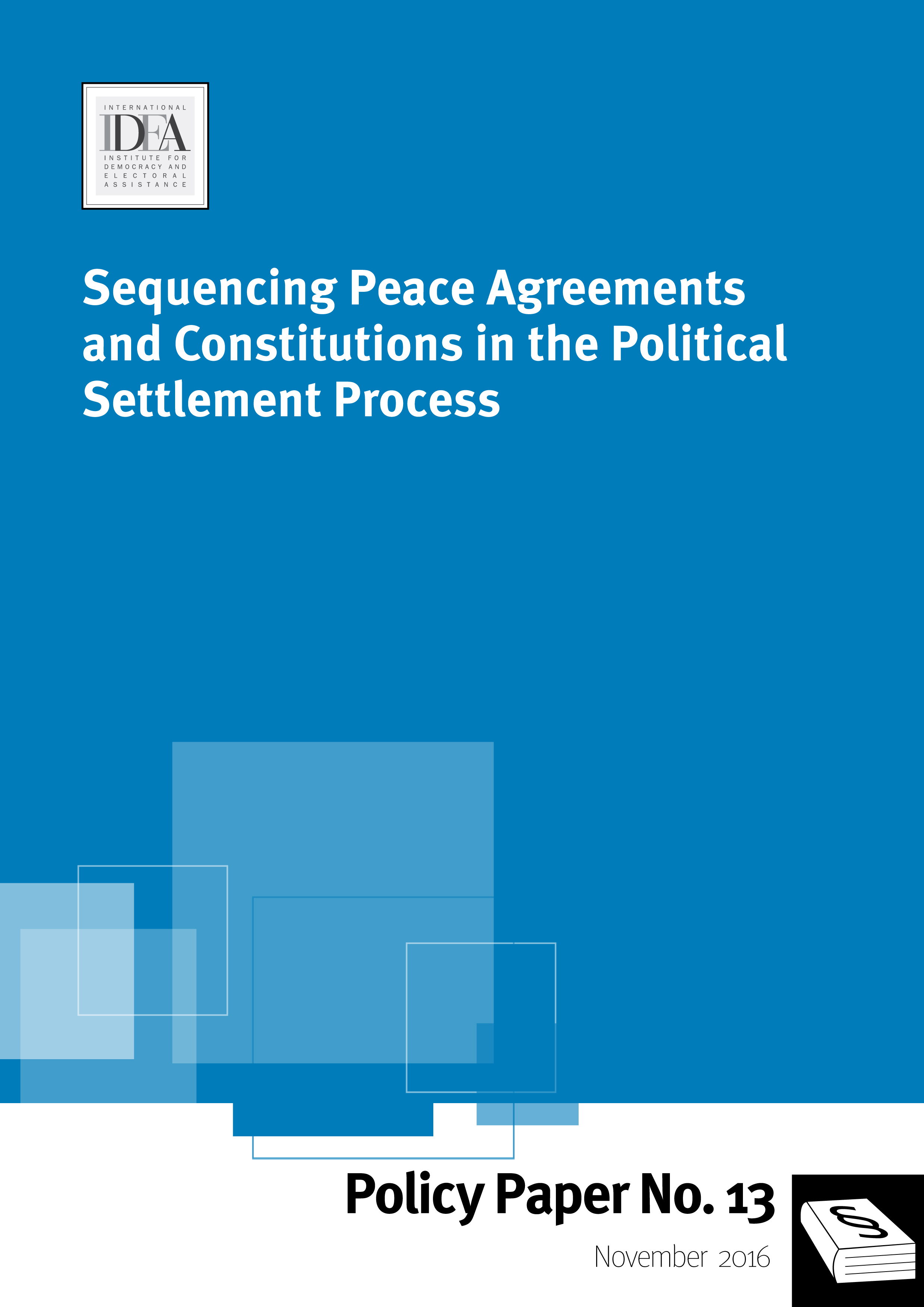Sequencing Peace Agreement and Constitutions in the Political Settlement Process

အကြမ်းဖက် ပဋိပက္ခများတွင် ဆွေးနွေးညှိနှိုင်း၍ရရှိလာသော သဘောတူညီချက်များသည် လွန်ဆွဲ လျက်ရှိသော ဇာတ်ဆောင်များအကြား လူအများလိုလားထောက်ပံ့သော နိုင်ငံရေးဖြေရှင်းချက်သစ်ရရှိ စေရန် ကြိုးပမ်းဆောင်ရွက်စေမည် ဖြစ်သည်။ ထိုသဘောတူညီချက်များတွင် အပစ်အခက်ရပ်စဲရေး သို့မဟုတ် ငြိမ်းချမ်းရေး သဘောတူညီချက်များ၊ ဖွဲ့စည်းပုံအခြေခံဥပဒေဆိုင်ရာ အစီအစဉ်များ အသေးစိတ်ရေးဆွဲထား သော စာရွက်စာတမ်းများ အစရှိသည်တို့ ပါဝင်သည်။ ဤသို့ဖြင့် ရရှိလာသော နိုင်ငံရေးဖြေရှင်းချက်များသည် နိုင်ငံ သို့မဟုတ် တိုင်းဒေသကြီးကို ပဋိပက္ခအခြေအနေမှ ဖွဲ့စည်းပုံအခြေခံဥပဒေဆိုင်ရာ ကတိကဝတ်များဖြင့် ကောင်းမွန်သောအုပ်ချုပ်ရေး နှင့် တရားဥပဒေစိုးမိုးမှုရှိသောအခြေအနေသို့ တွန်းပို့စေနိုင်သည်။
ရှေ့နောက်စီစဉ်ဆောင်ရွက်ခြင်းနှင့် ဆွေးနွေးညှိနှိုင်း၍ရရှိလာသော သဘောတူညီချက်များ၏ အောင်မြင်မှု သို့မဟုတ် ကျရှုံးမှုသည် အကြောင်းအချက်အချို့ပေါ်မူတည်ပါသည်။ ၎င်းတို့မှာ နိုင်ငံရေးဖြေရှင်းချက် ရရှိရန် တောင်ရွက်ခဲ့သည့်လုပ်ငန်းစဉ် ကွဲပြားမှုများ၊ ငြိမ်းချမ်းရေးသဘောတူညီချက်များနှင့် ဖွဲ့စည်းပုံအခြေခံဥပဒေ များသည် မည်သည့်အချိန်တွင် (မည်သို့ နည်းလမ်းများဖြင့်) နိုင်ငံရေးဖြေရှင်းချက် အဖြစ်သို့ ဖော်ဆောင် ပေးနိုင်ခဲ့သနည်း၊ ဖွဲ့စည်းပုံအခြေခံဥပဒေချမှတ်ခြင်းသည် မည်သည့်အချိန်တွင် (မည်သည့်အတွက်ကြောင့်) နိုင်ငံရေးဖြေရှင်းချက် လုပ်ငန်းစဉ်နှင့် ကွဲပြားသွားသနည်း၊ ထိုကွဲပြားသွားခြင်း၏ အကျိုးရလဒ်များ အစသည် တို့ ဖြစ်ပါသည်။
ဤမူဝါဒစာတမ်းသည် ဖွဲ့စည်းပုံအခြေခံဥပဒေရေးဆွဲခြင်းနှင့် ငြိမ်းချမ်းရေးတည်ဆောက်ခြင်း ပညာရပ် ဆိုင်ရာ စာပေလိုအပ်ချက်ကို ဖြည့်စီးပေးရန် ရည်ရွယ်သည်။ တည်ရှိပြီးသော ပညာရပ်ဆိုင်ရာစာပေများသည် ငြိမ်းချမ်းရေးသဘောတူညီချက်များနှင့် ဖွဲ့စည်းပုံအခြေခံဆိုင်ရာစီမံချက်များ၏ အပြန်အလှန်ဆက်ဆံရေး သက်ရောက်ချက်များကို ဖော်ပြချက်အသားပေးနှင့် စံတန်းဖိုးအသားပေးများ ဖြစ်ကြသည်။ ဤစာတမ်းသည် ငြိမ်းချမ်းရေးအပေးအယူများနှင့် ဖွဲ့စည်းပုံအခြေခံဥပဒေဆိုင်ရာ စီမံချက်များအား ရှေ့နောက်စီစဉ်ခြင်းများကို လေ့လာသုံးသပ်တင်ပြထားပြီး မည်သည့်အချိန်နှင့် (မည်သည့်အတွက်ကြောင့်) ရှေ့နောက်စီစဉ်ဆောင်ရွက် ခြင်းများသည် ကြောင်းကျိုးညီညွတ်သော ပုံစံများကို တစ်သတ်မှတ်တည်း လိုက်နာခြင်းမရှိကြောင်း၊ အမြှော် အမြင်ရှိ၍ လက်တွေ့ကျသော ဖွဲ့စည်းပုံအခြေခံဥပဒေဆိုင်ရာ သဘောတရားမူဘောင်များ၏ ရှုပ်ထွေးနက်နဲမှု များကို ပိုမိုနားလည်သဘောပေါက်စေရန် ရည်ရွယ်သည်။
In situations of violent conflict, negotiated agreements—including ceasefire or peace agreements and documents detailing constitutional arrangements—attempt to reach a new political settlement between the warring protagonists, which is ideally supported by the broader society.
Such political settlements aim to move the country or region from conflict to a situation characterized by constitutional commitments to good governance and the rule of law.
The sequencing—and the success or failure—of these negotiated agreements depends on a number of factors, including the diverse processes through which a political settlement is reached; when (and how) peace agreements and constitutions reach a political settlement; when (and why) constitution-making separates from the political settlement process; and the consequences of such a separation.
This Policy Paper aims to address the gap in the constitution-making and peacebuilding literatures regarding descriptive and normative accounts of the relationship between peace agreements and constitutional arrangements in political settlement processes. It explores the sequencing of peace deals and constitutional arrangements in order to better understand when (and why) sequencing does not follow the logical model, and the implications for any coherent and workable constitutional framework.